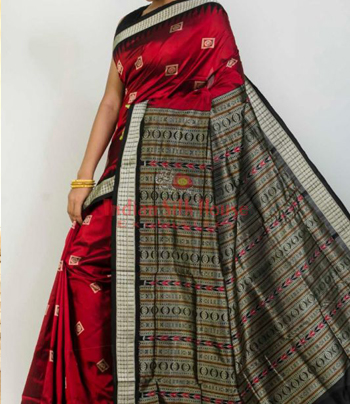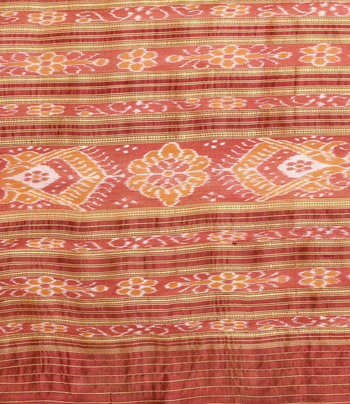Kotpad Handloom Fabric
Kotpad Handloom is a vegetable-dyed fabric woven by the tribal weavers of the Mirgan community of Kotpad village in Koraput district, Odisha, India. Cotton sarees with solid border and Pata Anchal, duppatta with typical Buties / motifs, Scolrfs on cotton, silk, handloom stoles, and dress materials are all dyed with organic dyes. The natural dye is manufactured from the aul tree grown in this area. The Kotpad tussar silk saree with tribal art and Kotpad handloom fabrics with natural color is its specialty.
Kotpad handloom fabric is the first item from Odisha that received the Geographical Indication of India tag, in 2005.The Mirgan community of Kotpad is famous for their exquisite organic dyed textile. They usually weave this textile for "Bhotada", "Dharua" and other motifs of their neighboring tribal communities.
Orissa Ikat
The Ikat is a Malayalam word introduced into European language by Rouffair which is derived from the word “Mangikat” meaning to bind, knoot or wind round. In India it is known by the name of “Bandhani'' in Malayan Peninsula Tjindai, Tjinde or Chindi and in Indonesia “Hol”. In India, the Ikat fabrics are produced in different names at different places. It is known as “Patola” in Gujarat, “Bandhani” in Rajasthan, “Pagudubandhu”, “Budhabus” and “Chitki” in Andhra Pradesh and “Bandha” in Orissa. Bandha fabrics of Orissa are done by Bhulia Meher Kustha, Ganda, Salvi, Gaudia-Patra, Asani-Patra, Padmasali and Devanga Weavers. Handloom Sarees having body as plain/buty /bandha (single & double Ikat) border as badi border with or without temple with dobby design/bandha (single & double Ikat) and anchal as bandha (single & double Ikat & Combined Ikat). Handloom dress materials with single & double Ikat & combined Ikat with or without buty. Handloom Scrafs/dupattas/stoles with body and anchal having single & double Ikat combined Ikat On Cotton, Silk and Tassar with or without border. Home furnishings with single & double Ikat & combined Ikat covering items like door and window screen, sofa and table cover, cushion cover, table mats, kitchen linens etc. Handloom handkerchiefs, bed covers, lungis and napkins with single & double Ikat & combined Ikat. Orissa Ikat is not confined to geometrical design, rather fine, sharp artistic curvilinear designs in the form of Lahari, Lata (creeper), Ghagra, Deuli (temple) etc. are its special characteristics.
Gopalpur Tussar Fabrics
The Gopalpur is known for the production of different Tussar fabrics and Saree. The product is produced in different parts of the Jajpur district of Orissa, namely Rasulpur, Dharmasala and Barachana blocks. A range of products is being churned out of these weaving hamlets. The products are Tussar yarn, Tussar Saree, Chadors, stoles, Dupattas, Bed sheet, Pillow cover, Cushion cover, Door screen, wall hanging, Ladies Dress Materials (LDMs), Table cloth and handkerchief, Cotton Saree, dress materials, Shirtings,etc. This cluster is the single largest tussar fabrics production centercentre in the state. The art of weaving of tussar fabrics in Gopalpur cluster is about 400 years old and is linked with the great saint Shri Chaitanya.
Dhalapathar Parda - Fabrics
The items manufactured in Dhalapathar are mainly Parda (door curtain), Wall hanging, Table cover, Lungi and Saree. Dhalapathar Parda (door curtain), due to its unique design and beauty has got places in the doors of many handloom, art and craft loving people of Orissa. The Parda is woven with thick threads by using a special weaving technique with the help of Chiaries and cotton handmade heald shafts.The Dhalapathar Sarees originally known as Kusmi Kapta, Nahati and Akata were woven with medium and coarser count threads like 26'and 40'cotton plied yarn gradually changed to fine count thread like 2/100' and 21120'with the same original designs resulting a very smooth textured and costly saree. The sarees are now popular among the middle and high class family women. The wall hangings are woven with same construction as door curtains with different sizes with different cultural designs. The Lungies are woven with very simple designs to keep the cost low with the similar weaving technique. The table covers are woven with similar technique and quality with designs suitable for the same.
Sambalpuri Bandha Saree - Fabrics
The range of products produced by the Sambalpuri Tie & Dye is large. The products are well embellished sarees , dress material (both cotton & silk), Home furnishings like door and window curtain, bed cover and bed spreads, table cloth, stoles, upholstery etc. l. Saree Sambalpuri saree is a traditionally woven ikat saree from Orissa. There are different type of Sambalpuri tie and dye saree; cotton saree, silk saree, silk and cotton mixed (Bapta), coarse cotton saree. Sambalpuri 'saktapar' Saree, this is the oldest form of Sambalpuri tie and dye. It has double ikat (described later) chequer board pattern and brocaded boader of 'rudraksha' bead compositions. In fact Sambalpuri cotton sarees have a smooth finish and a distinctly original border and pallu. Many traditional motifs like fish, conch shell, birds, animals and other floral designs are woven in fabrics. The Imperial Gazette observes "the flower bordered sarees of Sambalpur are called Phulia; and peculiar to the district are sarees known as 'Hansabali bordered' or striped with fantastic animal designs. These Hansabali are the most artistic product of the Central Provinces (Imperial Gazette, Govt. of India, pp. 199-200)". 2. Wall Hanging The wall hangings are one of the modem products of Sambalpuri tie and dye. The size of the wall hanging varies according to the design nurtured in the mind of the skilled weaver. Each design of wall hangings are weaven with a central theme. The theme is expressed in terms of motifs used in that particular design arranged in a decorative pattern. The name of the few designs are like 'Arka kshetra', 'Sankha kshetra', 'Sri kshetra', 'Soura kala' etc. 3. Individual Bed Sheet, Bed Cover, Pillow Cover/ Coordinate Set Specificotion: Bedsheets are woven for different sizes with different specifications. Colour: The colour range varies from very bright colour combinations to sober as well. Variety: There are two varieties of this with respect to quality. One is made of coarse coffon other is a smoother and fine one. Design: Mostly curves, checks and floral patterns are woven. Saptapad /saktapar ofbig sizes are used in bedsheets and bed covers. 4. Door Curtain: These are made of coarse cotton in general, where as smooth and well finished design and material are included in export quality door curtain (parda) and coordinated set. 5. Dress Material There are two types of dress material. 1: than (long cloth),2: ladies salwar suit piece, Dupattras, tops material. Ladies dress materials are mainly cotton tie and dye products, finer and decorative like that of Sambalpuri cotton saree. Small sactapads are popular in kurta piece in salwar suit materials. The salwar piece is either plain without any design or of mixed shades matching to the colour of the dupatta.(Long Scarf) 6. Dupattas and Others : The Dupattas (udhni) are woven with two side boarder and pallu at the two length ends. Stoles and Dupatta in both cotton and silk yarn is woven. The handkerchiefs are made with border in four sides and motifs at the centre.
Bomkai Saree - Fabrics
"Bomkai '' is the name of a design woven in handloom using Jalla technique. The design is not confined to geometrical shape and size and also floral, ornamental, attractive with more prominence in designs like dancing doll, chariot, trees, duck, tortoise, fish, Buta, Buti, and creepers. It is an extra weft design with single color or multi colour weft on the cloth. . The special attachments of Jalla sets like Dandi Rasi (pagia threads), Bouy (naka threads) and Langal (ankda) fitted to the loom for making bomkai design on cloth. One assistant is required with the weaver for lifting the jalla during weaving. The designs on the fabrics are woven one side only. The solid border, anchal and body designs are also combined with ikat technique. There is scope for multiple designs on the body/anchal of the fabric by use of one or more jalla sets. Design is woven in extra weft with 4 to 8 Ply threads.
Habaspuri Saree - Fabrics
Habaspuri fabrics are one of the most popular tribal based fabrics of Orissa. The products categories include Sarees and Stoles (Dupattas). The products are well embellished with various motifs seen in nature. Sarees are produced both in cotton and silk whereas Dupattas are produced only in Cotton. For dyeing pu{pose, Natural extracts of barks and fruits of local forest trees and some selected synthetic dyes which are not harmful to human skins are used. Raw materials used are mulberrv silk and mercerized cotton of 2/100s and 2lI20s count.
Saree: The varieties of Habaspuri sarees are produced both in Cotton and Silk. The Saree has a remarkable Anchal lavishly decorated by traditional motifs, like fish, flower & tortoise lined by ribs (Danti). Body is decorated with small Buties. The boarder is decorated with the same traditional motifs in vertical wav which looks very attractive. Stoles (Dupatta): Dupattas are produced in 2/100's and 21120's cotton decorated with the same traditional motifs on both the borders as well as on the Anchal or pallu
Khandua Saree And Fabrics
The origin of the product traced back to 12th century AD, as the product is closely associated with the rituals of the famous Lord Jagannath Temple of Puri in Orissa. It is believed that, during 12th century AD, Jaydev, the famous poet, desired to offer his magnomopous “Gitagovinda” to Lord Jaganath. He finds the silk fabric as a medium for offering the Gitagovinda to lord.
The products like Mercerised cotton sarees, tussah sarees, cheddars, stoles, dupattas, bed sheets, bed covers, pillow covers, cushion covers, door screens, wall hangings, ladies dress materials, shirting’s, table cloths and handkerchiefs etc. Motifs like star temple conch, rudrakhya, fish, chakra, lotus, swan, peacock, parrot, deer, elephant, horse, lion, dance of devadasi, Gitagovinda on fabric, different types of scenery. Tyeing of weft for Khandua design in done for 4,8,24 sarees at time. Khandua warping is done by cylindrical warping drum for 24 to 32 pieces of sarees at a time. 5) Weaving is done in a fly shuttle frame loom having auto take up motion and dobby attachment (usually 8 to12 levers dobby are used for selvedge design).
Kotpad Handloom Fabric
Kotpad Handloom is a vegetable-dyed fabric woven by the tribal weavers of the Mirgan community of Kotpad village in Koraput district, Odisha, India. Cotton sarees with solid border and Pata Anchal, duppatta with typical Buties / motifs, Scolrfs on cotton, silk, handloom stoles, and dress materials are all dyed with organic dyes. The natural dye is manufactured from the aul tree grown in this area. The Kotpad tussar silk saree with tribal art and Kotpad handloom fabrics with natural color is its specialty. Kotpad handloom fabric is the first item from Odisha that received the Geographical Indication of India tag, in 2005.The Mirgan community of Kotpad is famous for their exquisite organic dyed textile. They usually weave this textile for "Bhotada", "Dharua" and other motifs of their neighboring tribal communities.
Recently, Biswanath Rath, an Indian Writer-Director, has made an English Documentary titled 'Kotpad Weaving : The Story of a Race Against Time' about Kotpad Handloom, dyeing and weaving which has been produced by PSBT in association with Doordarshan. This documentary was telecasted on DD National on 24 March 2018. The film explores the uniqueness of Kotpad Handloom, the issues and possible solutions for revival of Kotpad Weaving and Dyeing. In 2018, Gobardhan Panika, one of the master weavers of the craft, was honored by the Government of India with the fourth highest civilian honor of the Padma Shri.
Source: Intellectual Property India
























